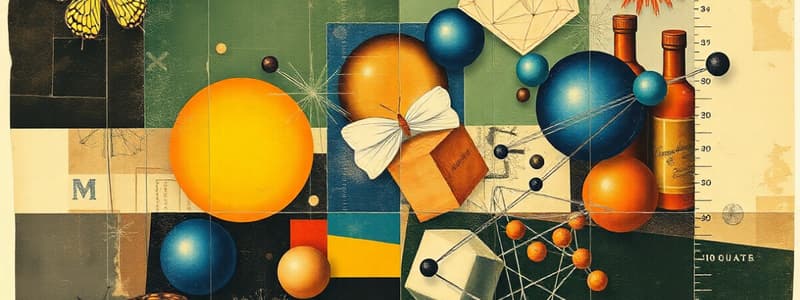Podcast
Questions and Answers
What is the primary difference between ionic and covalent bonds?
What is the primary difference between ionic and covalent bonds?
- Covalent bonds involve the sharing of electrons. (correct)
- Ionic bonds form between atoms with equal electronegativity.
- Covalent bonds are formed by the attraction of opposite charges.
- Ionic bonds involve the sharing of electrons.
Which statement accurately describes an isotope?
Which statement accurately describes an isotope?
- Isotopes of an element have different atomic numbers.
- An isotope has the same number of neutrons but different number of protons.
- An isotope retains the same number of protons but has a different number of neutrons. (correct)
- Isotopes are atoms that have completely different chemical properties.
Which characteristic of water contributes to ice floating on it?
Which characteristic of water contributes to ice floating on it?
- Water becomes less dense when it freezes due to hydrogen bonding. (correct)
- Water molecules form ionic bonds in ice.
- Ice is denser than liquid water due to hydrogen bonding.
- The density of ice is greater than that of liquid water.
What role does a negative control serve in an experiment?
What role does a negative control serve in an experiment?
Which of the following is correctly defined within the scientific method?
Which of the following is correctly defined within the scientific method?
Which of the following describes the structural difference between saturated and unsaturated fatty acids?
Which of the following describes the structural difference between saturated and unsaturated fatty acids?
What is the primary function of carbohydrates in organisms?
What is the primary function of carbohydrates in organisms?
Which of the following correctly compares cis-fats and trans-fats?
Which of the following correctly compares cis-fats and trans-fats?
What type of bond is primarily involved in the formation of the secondary structure of proteins?
What type of bond is primarily involved in the formation of the secondary structure of proteins?
Which of the following statements about functional groups is correct?
Which of the following statements about functional groups is correct?
Flashcards
Characteristics of Living Organisms
Characteristics of Living Organisms
Features that define life, like growth, reproduction, and response to stimuli.
Positive Control
Positive Control
A group in an experiment that receives a treatment known to produce results.
Negative Control
Negative Control
A group that does not receive the experimental treatment, ensuring any changes are due to the treatment.
Isotope
Isotope
Signup and view all the flashcards
Ionic Bond
Ionic Bond
Signup and view all the flashcards
Functional Groups
Functional Groups
Signup and view all the flashcards
Monosaccharides
Monosaccharides
Signup and view all the flashcards
Triglycerides
Triglycerides
Signup and view all the flashcards
Peptide Bond
Peptide Bond
Signup and view all the flashcards
Cholesterol Structure
Cholesterol Structure
Signup and view all the flashcards
Study Notes
Key Concepts for Exam I - ISB 204
-
Living Organisms:
- Be able to analyze, explain, interpret, and chart/graph experimental data.
- Know the characteristics of living organisms.
- Compare and contrast archaea, bacteria, and eukarya.
-
Scientific Method:
- Define hypothesis, experiment, conclusion, and theory.
- Design experiments with positive and negative controls, explaining their purpose.
-
Atoms & Elements:
- An atom is the smallest part of an element retaining its properties.
- The nucleus contains protons and neutrons.
- The number of electrons equals the number of protons.
- Atomic number = number of protons.
- Mass number = number of protons + neutrons.
- Isotopes have the same number of protons but different numbers of neutrons.
- The octet rule describes how atoms bond to achieve a stable outer electron shell (8 electrons).
- Ionic bonds form from the attraction of positive and negative charges.
- Covalent bonds form by sharing electrons.
- Distinguish between nonpolar and polar covalent bonds.
-
Water:
- Understand the properties of water (specific heat, heat of vaporization, heat of fusion).
- Explain why ice floats.
- Describe how water molecules form hydrogen bonds.
-
Functional Groups:
- Understand the role of carbon and its characteristics (functional groups).
- Recognize different functional groups and their structural features.
-
Carbohydrates:
- Describe the function and general structure of carbohydrates.
- Recognize the structure of glucose.
- Differentiate between monosaccharides, disaccharides, and polysaccharides.
-
Lipids:
- Recognize the structure of fatty acids, glycerol, and triglycerides.
- Compare and contrast saturated and unsaturated fatty acids.
- Discuss the effects of saturated, unsaturated, and trans fats on health.
- Describe the structure of phospholipids, cholesterol, and steroids.
- Understand the roles and effects of steroids.
-
Proteins:
- Describe the various functions of proteins.
- Recognize amino acids.
- Describe peptide bonds.
- Explain primary, secondary, tertiary, and quaternary protein structure.
- Describe bonds and interactions involved in protein structures.
- Hydrophobic and hydrophilic interactions
- Disulfide bonds
Studying That Suits You
Use AI to generate personalized quizzes and flashcards to suit your learning preferences.




